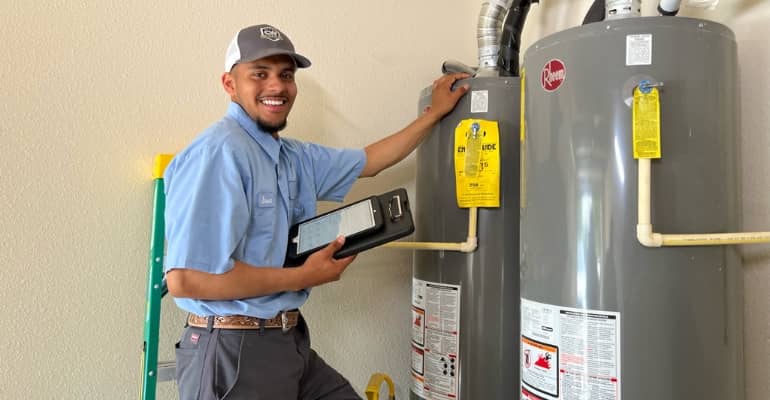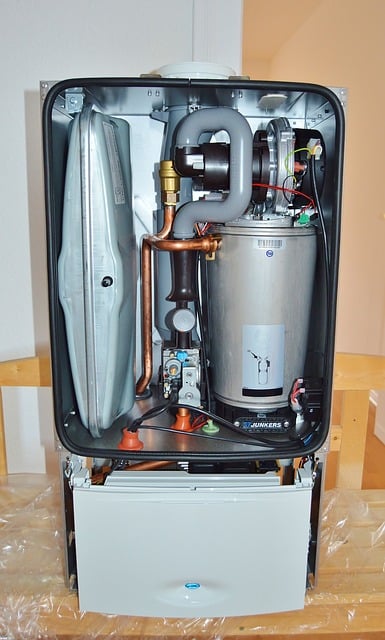Systems that use hot water tanks are the most common type of water-heating system in U.S. homes…

..So Why Do You Need to Know How Your Water Heater Works?
If your home relies on a conventional water heater for hot water, it’s useful to have a good understanding of how the system operates because:
- If the system ever breaks down, you’ll be able to tell if it’s something you can DIY or if you need to call in a professional.
- You can talk more knowledgeably with plumbing technicians, making it easier to get repairs and maintenance work done.
- When it’s time to replace the tank, you’ll have some background knowledge that can help you make the best purchase choices.
How Does a Water Heater Work?
A hot water tank is a metal drum that can hold a large amount of water—between 20 and 80 gallons or more, depending on the size of the tank.
The tank has an intake pipe at the bottom, where cold water enters. At the top of the tank, an outlet pipe takes hot water from the tank to wherever it’s needed. Inside the tank are heating elements and other components that make the system work.
Hot water tanks are structured this way to take advantage of the fact that heat rises. This means the cold water entering the tank at the bottom doesn’t affect the temperature of the water at the top.
When you turn on a hot water faucet (or an appliance that needs hot water), heated water moves out of the tank, through the pipes in your home, and to the faucet. This makes the water level in the tank drop. The tank is then refilled with cold water. The influx of cold water triggers the thermostat, which tells the heating element to kick in. The heat stays on until the whole tank is at the set temperature. At that point the thermostat switches off until it’s needed again.
What’s Inside a Hot Water Tank?
Within a hot water tank are a number of components. The tank is insulated to protect against heat loss. It has an intake pipe at the bottom and an outlet pipe at the top.
Components include:
Heating element: The heating element is typically located in the bottom part of the tank. In an electric system the heating element is a metal coil, fixed to the side of the tank. In a gas-powered system there’s a gas burner underneath the water-containing part of the tank.
Thermostat: This controls the temperature of the water. In electric tanks with more than one heating element, each element may be controlled by a separate thermostat.
Sacrificial anode: This is a piece of metal that is fixed in place at the top of the tank. One end of the rod extends inside the tank, and the other end is outside the tank. The anode has a steel core and is coated in magnesium or aluminum. These are metals that corrode more readily than the metal that the tank is made of. With the sacrificial anode rod in place, the tank is protected from rusting. Anodes need to be replaced every few years because eventually all the metal coating on the rod rusts away, which leaves the tank vulnerable.
Gas-control valve: In a gas hot water tank this valve controls the flow of gas to the burner.
Drain valve: A valve located near the bottom of the tank, this is used to drain the tank when repairs or maintenance are needed.
Pressure relief valve: This keeps the water pressure inside the tank at a safe level.
Tank-based hot water heaters use these same basic components to heat water, but gas and electric systems use different methods to generate heat.

Electric Hot Water Tanks
In an electric tank the heating element is located inside, similar to an electric kettle. The heating element inside an electric hot water tank is a copper coil. When the thermostat triggers, electricity runs through the coil. This causes the coil to heat up, which heats the cold water at the bottom of the tank.
To Turn the Tank On
Turning on an electric tank is fast and easy if the tank is already full. You just need to turn the circuit breaker on and then wait for the water to heat up. For some tanks, there may also be a circuit switch either on the tank itself or on a wall nearby.
If the tank is empty, you first need to make sure the drain valve is closed. Next, open a hot water faucet located close to the tank. Finally, open the intake valve on the tank. This allows the tank to fill up. You’ll know it’s full when there’s a steady stream of water coming out of the open faucet. You can then shut off the faucet. Flip the circuit breaker to the ON position, then turn on the circuit switch if there is one.
Electric with Heat Pump (AKA Hybrid Water Heater)
An electric-powered tank can be combined with a heat pump to reduce the amount of energy needed to heat the water and keep it hot over time. The heat pump is mounted at the top of the tank.
Heat pumps use an evaporator coil and refrigerant to pull heat from the air, and a condenser to distribute the heat where it needs to be. In a hot water system, heat is pulled from the air around the tank. The condenser for the heat pump is located inside the tank so that heat is released into the tank to heat the water.
Heat pumps work best in warmer climates, as they’re less efficient when temperatures drop below 40 degrees Fahrenheit. Because they trap ambient heat, they work best when installed in warm areas, such as a furnace room.
Gas-Powered Hot Water Tanks
In a gas-powered hot water tank, the burner can’t be situated in with the water, like with an electric tank. Instead, the burner is underneath the tank in a separate compartment. A gas chimney extends from the burner upwards into the interior of the tank. Heat generated by the burner is transferred to the surrounding water, both from the burner directly and from the chimney.
The chimney extends past the top of the tank, at which point it becomes a ventilation shaft. This vents combustion gases to the outside.
Gas-powered tanks have a pilot light that’s always on. When hot water is used, the flow of incoming cold water triggers the gas burner to ignite, similar to the way a furnace works. Once the gas burner is going, the transference of heat from the burner and the chimney to the water heats the water.
To Turn the Tank On
To turn on a gas system, the safest way to start is to make sure that the temperature on the tank is set low. The gas-control valve on the tank should be turned off. Once the gas-control valve is turned off, you should wait 10 minutes before proceeding. This is important to ensure there’s no accumulated gas in the pilot light chamber.
After 10 minutes, switch the gas-control valve to the Pilot setting. You can then light the pilot light.
In newer models you can light the pilot light by pressing the igniter button, typically for 30 to 90 seconds, depending on the model. You may also need to press a gas-control dial to get gas flowing to the pilot light.
In older tanks you’ll need to manually light the pilot light. It’s best to use a long-neck lighter for this. Some models may require you to open up an access panel to find the pilot light. If you do, make sure you close the access panel after lighting the pilot light and before turning the tank on.
Once the pilot light is on, you can turn the tank on and set the thermostat to the temperature you want. Since the water is cold at this point, you should soon hear the burner start to work.
Note: If you smell gas at any point, stop and evacuate immediately, then call emergency services for help. Don’t try to light the pilot light if you smell gas.
Water Heater Warranties
Water heater tanks last 8 to 12 years, with an average 10-year lifespan. However, not all product warranties last that long.
Water heater warranty options include:
- Product warranty: Provided by the tank manufacturer and typically good for six to eight years. It covers issues related to product defects. Your hot water tank must be installed by a licensed plumber, otherwise the product warranty may not be valid.
- Extended warranty: Provided by the tank manufacturer. For an additional fee, you get an extra one-to- four years’ worth of product warranty coverage.
- Water heater warranty: If you have a home warranty, you can usually get water heater coverage either inclusive or as an add-on. This warranty applies if the tank malfunctions after the manufacturer’s warranty has expired.
For Water Heater Installation, Maintenance, and Repair, Call CW Service Pros
Take good care of your hot water heater, and it will take good care of your family’s hot water needs. To keep the whole system in great shape for its entire lifespan, add CW Service Pros to your Contacts list. We’re here for hot water tank installations, repair, and maintenance, and we’re on-call 24/7 for emergencies too!

















